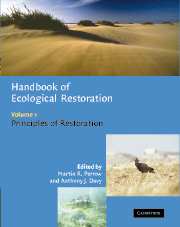Book contents
- Frontmatter
- Contents
- List of contributors
- Foreword
- Preface
- Part 1 The background
- Part 2 Manipulation of the physical environment
- Part 3 Manipulation of the chemical environment
- Part 4 Manipulation of the biota
- 12 Establishment and manipulation of plant populations and communities in terrestrial systems
- 13 Ecology and management of plants in aquatic ecosystems
- 14 Micro-organisms
- 15 Terrestrial invertebrates
- 16 Aquatic invertebrates
- 17 Fish
- 18 Reptiles and amphibians
- 19 Birds
- 20 Mammals
- Part 5 Monitoring and appraisal
- Index
- References
17 - Fish
Published online by Cambridge University Press: 29 December 2009
- Frontmatter
- Contents
- List of contributors
- Foreword
- Preface
- Part 1 The background
- Part 2 Manipulation of the physical environment
- Part 3 Manipulation of the chemical environment
- Part 4 Manipulation of the biota
- 12 Establishment and manipulation of plant populations and communities in terrestrial systems
- 13 Ecology and management of plants in aquatic ecosystems
- 14 Micro-organisms
- 15 Terrestrial invertebrates
- 16 Aquatic invertebrates
- 17 Fish
- 18 Reptiles and amphibians
- 19 Birds
- 20 Mammals
- Part 5 Monitoring and appraisal
- Index
- References
Summary
INTRODUCTION
Fish exhibit far greater diversity than any other vertebrate group with 20 000 living species (Nelson, 1984), more than twice as many as birds or reptiles and amphibians and four times as many as mammals. Fish have colonised nearly all waters on the planet from the deepest oceans to temporary pools, with a diversity of form, ecology and biology to match. Around 1% of fish have even mastered the physiological stresses of migrating from salt to fresh waters and vice versa (Nelson, 1984). The fact that fish are supported in water has provided terrific scope for body size range. In the sea, only the great whales attain greater size than the 12.5 m long, 12.5 tonne whale shark (Rhincodon typus), making fish some of the largest vertebrates alive. At the other extreme the pygmy goby (Pandaka pygmaea) is 250 million times smaller, reaching 7.5–9.9 mm at adult size.
Fish may be carnivores, herbivores, detritivores and both external and internal parasites, specialising on all conceivable prey items from whole fish to parts of fish (scales, fins and blood) other vertebrates (including mammals), invertebrates, algae, fruit and plankton of various sorts. The radiation of fish into virtually every available aquatic niche has, in many cases, left them vulnerable to extinction as aquatic systems have been extensively modified and exploited of their resources. Several major river basins such as the Amazon are also likely to retain a relatively high proportion of unknown species.
- Type
- Chapter
- Information
- Handbook of Ecological Restoration , pp. 324 - 354Publisher: Cambridge University PressPrint publication year: 2002
References
- 1
- Cited by



